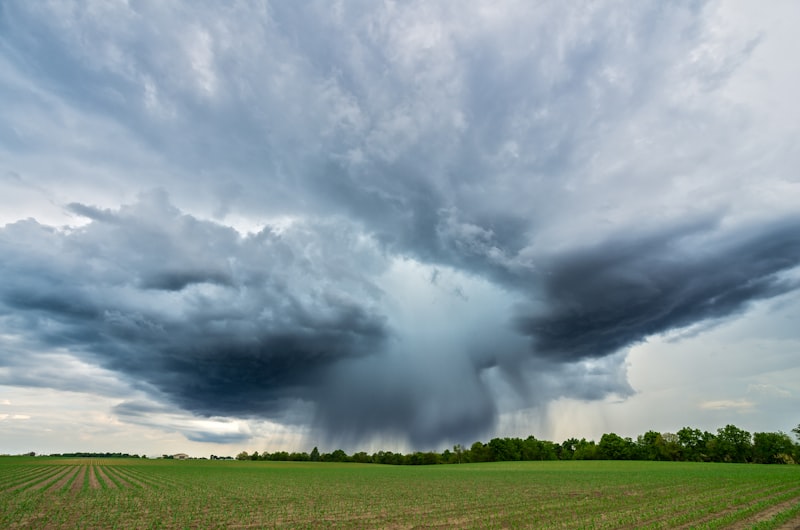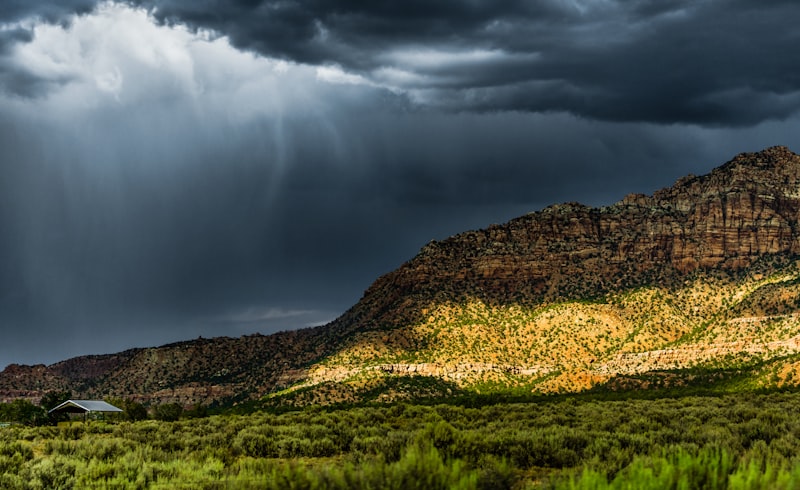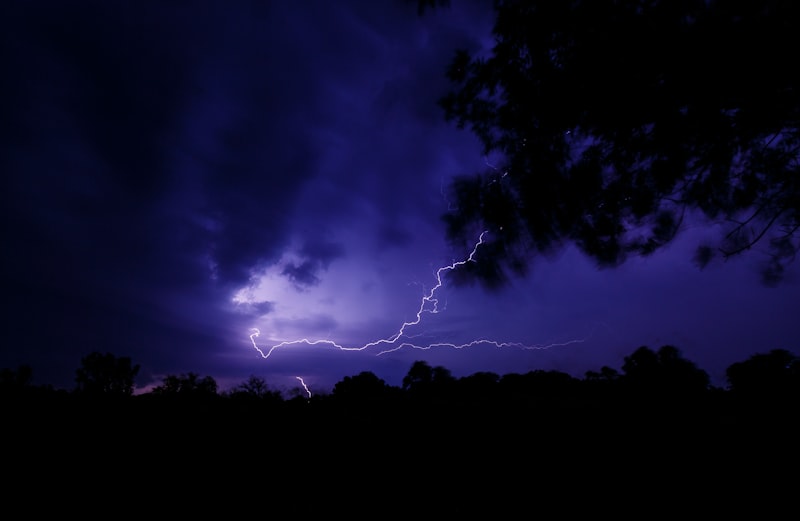Consider the majestic power of lightning storms, where bolts of electricity dance across the sky. These awe-inspiring displays are not just flashes of light; they’re manifestations of atmospheric conditions colliding in a dramatic spectacle. The heat generated by lightning can exceed 30,000 degrees Celsius, hotter than the surface of the sun, transforming the air around it and sometimes causing wildfires.
On the gentler side, consider the soothing effect of rainfall. As droplets cascade from the sky, they nourish the earth and sustain life. Rainfall patterns dictate the growth of crops, the flow of rivers, and the survival of entire ecosystems. In areas where rain is scarce, such as deserts, even a slight increase in precipitation can trigger a burst of colorful wildflowers, a testament to nature’s resilience and adaptability.
Wind, another product of weather systems, shapes landscapes over centuries. From the smooth curves of sand dunes sculpted by desert breezes to the jagged cliffs shaped by coastal gusts, wind is a master sculptor of our natural world. It carries seeds for plants to colonize new territories, disperses pollen for reproduction, and even drives the migration patterns of birds and insects.
Seasonal changes, driven by weather patterns, orchestrate the ballet of nature’s calendar. The arrival of spring awakens dormant plants and animals, triggering migrations, blossoming flowers, and the birth of newborn animals. In contrast, the onset of winter heralds a period of dormancy and survival strategies, from hibernation to migration, adapted by various species to endure harsh conditions.
Unveiling Nature’s Symphony: How Weather Shapes Spectacular Natural Events
Weather, in its myriad forms, plays a pivotal role in shaping some of the most breathtaking natural events on Earth. From the towering peaks of the Himalayas to the vast expanse of the Sahara Desert, every corner of our planet bears witness to the symphony of weather.
Let’s delve into this symphony and uncover how weather influences these natural marvels.
Rainbows, for instance, are not just arcs of color but a harmonious blend of sunlight and raindrops. When sunlight breaks through droplets in the aftermath of a rain shower, it creates a kaleidoscope of hues that captivate our imagination. Have you ever wondered how something as simple as rain and sunlight can create such a vivid display?
Volcanic eruptions, on the other hand, are a dramatic manifestation of atmospheric pressure and geological forces colliding. As magma surges from the Earth’s core and meets cooler air, it triggers explosive reactions that can reshape landscapes in an instant. The fiery lava flows and ash clouds are nature’s way of reminding us of its raw power.
Hurricanes and tornadoes, though destructive, are fascinating examples of atmospheric dynamics. These swirling tempests, fueled by warm ocean waters and complex wind patterns, unleash unparalleled energy. They reshape coastlines, uproot trees, and leave behind a trail of both devastation and renewal.
Weather’s Secret Role: How Atmospheric Conditions Drive Natural Phenomena
Have you ever wondered how something as ordinary as weather can hold the key to some of nature’s most spectacular events? From the towering thunderstorms that light up the sky to the gentle snowfall that blankets the landscape, atmospheric conditions play a pivotal role in shaping our environment.
Take lightning, for example. This dazzling display of electricity in the sky is a direct result of atmospheric instability. When warm air rises rapidly and collides with cooler air above, it creates an electrical charge that eventually discharges as lightning. It’s nature’s way of balancing the atmosphere’s electrical potential, often with breathtaking results.
But it’s not just lightning that owes its existence to weather patterns. Hurricanes, those colossal storms that churn over warm ocean waters, are fueled by the heat and moisture evaporating from the sea surface. As this warm, moist air rises and condenses, it releases latent heat, further intensifying the storm and driving powerful winds and torrential rainfall.
Even something as serene as a rainbow has its origins in the interaction between sunlight and raindrops. When sunlight passes through droplets of water suspended in the air, it refracts and reflects, creating the spectrum of colors that we see arcing across the sky. It’s a reminder of how the simplest elements of nature can come together to create something truly magical.
And let’s not forget the more subtle effects of weather on our daily lives. The gentle breeze that rustles through the trees, the refreshing scent of rain on a hot summer’s day – these are all moments shaped by the ebb and flow of atmospheric conditions. They remind us of the interconnectedness of all things in nature, where even the slightest change in weather can have profound effects on our surroundings.
Weather isn’t just a topic of conversation or a daily forecast; it’s a powerful force that shapes the world around us. From the grand spectacle of thunderstorms to the quiet beauty of a rainbow, atmospheric conditions play a crucial role in driving the natural phenomena that inspire awe and wonder. So next time you step outside and feel the wind on your face or see the flash of lightning in the distance, take a moment to appreciate the hidden forces at work all around us.
From Sun to Storms: Weather’s Impact on Earth’s Natural Wonders
In contrast, the tropical rainforests of the Amazon Basin experience a different facet of weather’s impact. Torrential downpours, fueled by humidity and warmth, sustain the lush biodiversity that thrives beneath the dense canopy. These rainforests, often referred to as the “lungs of the Earth,” owe their existence to the relentless cycle of precipitation and sunlight, which fosters unparalleled biological richness.
Moving to the deserts of the Sahara, weather assumes a starkly different guise. Here, scorching temperatures under a relentless sun transform the landscape into an arid expanse where only the hardiest of life forms endure. The shifting sands and rocky outcrops bear witness to the erosive power of occasional desert storms, which reshape dunes and cliffs in a timeless dance of wind and sand.
In coastal regions, the weather takes on a dual role as both creator and destroyer. Along the jagged cliffs of the Pacific Northwest, relentless waves sculpt sea stacks and arches, while coastal storms unleash their fury, eroding shorelines and reshaping coastal geology. The iconic Great Barrier Reef of Australia, under the influence of warm seas and sunlight, hosts a kaleidoscope of coral life, illustrating how weather can nurture fragile ecosystems.
Across the globe, from the Arctic tundra to the Antarctic ice shelves, weather weaves its intricate tapestry on Earth’s natural wonders. It is the driving force behind the awe-inspiring beauty of glaciers, the dynamic ebb and flow of rivers, and the rhythmic pulse of seasons that dictate the lives of flora and fauna alike. Indeed, from sunlit serenity to stormy tumult, the weather’s impact on our planet’s natural treasures is both profound and endlessly fascinating.
Forecasting Wonder: The Science Behind Weather’s Influence on Natural Phenomena
At its heart, weather forecasting is both an art and a science—a delicate balance of observation, prediction, and interpretation. Meteorologists harness a vast array of tools and technologies to decode the atmosphere’s mysteries, from satellites that peer down on swirling cloud patterns to ground-based sensors measuring humidity and temperature fluctuations. These data points are the brushstrokes that paint the canvas of our weather forecasts, guiding us through the daily ballet of sunshine, rain, wind, and snow.

The impact of weather on natural phenomena is undeniable. Take, for instance, the majestic migration of birds. Guided by instinct and environmental cues, birds embark on epic journeys spanning continents, timed with precision to coincide with favorable weather patterns. A shift in wind direction can alter their flight paths, showcasing the intricate relationship between atmospheric conditions and animal behavior.
In coastal regions, the ebb and flow of tides are choreographed by lunar cycles and influenced by atmospheric pressure systems. Storm surges, driven by powerful hurricanes or typhoons, can reshape coastlines in a matter of hours, demonstrating nature’s raw power unleashed.

Even the subtlest changes in weather can ripple through ecosystems, affecting plant growth, animal behavior, and human activities alike. Farmers rely on seasonal forecasts to plan crop rotations and irrigation schedules, while outdoor enthusiasts monitor weather patterns for optimal conditions to hike, ski, or sail.
The science of weather forecasting illuminates the interconnectedness of natural phenomena. It invites us to marvel at the intricate tapestry woven by atmospheric forces, shaping landscapes, livelihoods, and the very rhythms of life itself. As we peer into the future, guided by advances in meteorology and climate science, we continue to deepen our understanding of how weather influences the world around us—a testament to the enduring wonder of nature’s symphony.
The Dance of Elements: Exploring Weather’s Influence on Nature’s Marvels

Nature’s canvas is often painted by the delicate brushstrokes of weather, a masterful choreography of elements that shape the world around us. From the gentle caress of a breeze to the tumultuous roar of a storm, weather influences every facet of our natural environment, creating marvels that captivate and inspire.
Imagine the majestic cliffs sculpted by centuries of wind and rain, standing tall against the backdrop of an azure sky. These natural monuments bear witness to the patient artistry of weather, each crevice and curve a testament to its enduring influence. Just as an artist meticulously shapes clay, so does weather mold landscapes, leaving behind breathtaking vistas that stir the soul.
In the heart of a forest, raindrops orchestrate a symphony on the leaves, their pitter-patter a soothing melody that nourishes the earth. The dance of water and sunlight gives rise to lush green canopies, where life flourishes in abundance. Here, weather is not just an observer but a vital participant, fostering growth and renewal with each passing season.
On the open plains, the drama unfolds as lightning streaks across the sky, illuminating the nocturnal ballet of clouds. Thunder reverberates through the air, a reminder of nature’s raw power and unpredictability. Yet, even amidst the storm’s fury, there is a beauty that commands respect—an untamed elegance that speaks to the resilience of life in the face of adversity.
In coastal realms, the ocean’s embrace shapes landscapes with its relentless tides and gentle caresses. Weather sculpts sandy shores and rocky cliffs alike, crafting havens for diverse ecosystems that thrive in harmony with the ever-changing sea. Here, the interplay of water and wind creates habitats of unparalleled beauty, where marine life and terrestrial wonders converge.
From the icy realms of polar caps to the sun-drenched expanses of deserts, weather leaves its indelible mark on every corner of our planet. It is a storyteller, weaving narratives of creation and destruction, of growth and transformation. The dance of elements continues unabated, a perpetual symphony that unfolds with each passing day, reminding us of nature’s enduring power and beauty.
Frequently Asked Questions
What are some examples of how weather affects ecosystems and wildlife?
Explore how weather impacts ecosystems and wildlife through examples like extreme temperatures affecting animal behavior, droughts leading to food shortages, and floods altering habitats and migration patterns. Discover more about these interactions and their ecological consequences.
How does climate change impact weather-related natural phenomena?
Climate change influences weather-related natural phenomena by intensifying extreme weather events such as hurricanes, heatwaves, and heavy rainfall. It alters weather patterns, leading to more frequent and severe storms, droughts, and floods globally.
What role does weather play in the formation of lightning and thunderstorms?
Discover how weather conditions contribute to the creation of lightning and thunderstorms. Learn about the atmospheric processes that lead to these natural phenomena.
Can weather conditions influence volcanic eruptions and earthquakes?
Weather conditions can indirectly influence volcanic eruptions and earthquakes by potentially triggering secondary effects like landslides or volcanic mudflows (lahars). However, they do not directly cause these geological events.
How does weather affect natural disasters like hurricanes and tornadoes?
Learn how weather conditions influence the formation and intensity of hurricanes and tornadoes.


